 THE
NIGHT WALKER (1964)/DARK INTRUDER (1965)
THE
NIGHT WALKER (1964)/DARK INTRUDER (1965)Directors: William Castle and Harvey Hart
Universal/TCM
 THE
NIGHT WALKER (1964)/DARK INTRUDER (1965)
THE
NIGHT WALKER (1964)/DARK INTRUDER (1965)A socko 1960s vintage horror double feature...with some unfortunately significant transfer issues. TCM Selects and Universal have released THE NIGHT WALKER AND DARK INTRUDER HORROR DOUBLE FEATURE, including director William Castle's 1964 psychological horror murder mystery THE NIGHT WALKER, starring Robert Taylor and Barbara Stanwyck, and DARK INTRUDER, with Leslie Nielsen and Peter Mark Richman, an unsold 1964 television pilot produced by Alfred Hitchcock's Shamley Productions/Universal which was deemed too violent for TV and was instead released to theaters in 1965. Both titles make their long-awaited DVD debut here, but authoring problems with THE NIGHT WALKER may make you want to keep that old full-frame Universal VHS copy of this shocker.
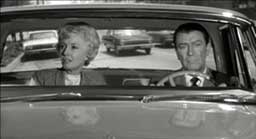
Beautiful, lonely, desperate Irene Trent (Barbara Stanwyck, CATTLE QUEEN OF MONTANA, WALK ON THE WILD SIDE) is having dreams a married woman shouldn't be having. The wife of fabulously wealthy inventor Howard Trent (Hayden Rorke, WHEN WORLDS COLLIDE, TV's I DREAM OF JEANNIE), the couple live in a palatial mansion (the Higgins-Verbeck-Hirsch House for movie location fans) where Irene should be content, and not tortured nightly by frustrating dreams of an unseen romantic lover. Howard, however, is blind and psychotically jealous of Irene (he tapes all conversations in the home), not allowing her to leave the house. The only visitor she sees is Barry Moreland (Robert Taylor, UNDERCURRENT, THE DAY THE HOT LINE GOT HOT), the suave, handsome lawyer who watches over the Trent holdings. When Howard is blown up in a freak accident in his laboratory, Irene thinks she's finally free of her husband's insanely possessive grasp. She even tells Barry to sell the house, because she's moving into the back room of the swank beauty parlor she owned before she met Howard. However, Irene's nightly reveries of a "dream lover" don't stop — they intensify, to the point where she meets "The Dream" (Lloyd Bochner, POINT BLANK, THE DUNWICH HORROR), and even marries him in a bizarre, surreal ceremony. Did any of this really happen to Irene? Is she dreaming all of this? More frighteningly: has Howard's corpse somehow come back to kill her?
 THE
NIGHT WALKER was the first of a new three-picture contract director William
Castle (HOMICIDAL, HOUSE ON HAUNTED HILL) signed for Universal after leaving
long-time studio Columbia Pictures. It also reunited Castle with Psycho
novel author Robert Bloch (THE SKULL, TORTURE GARDEN), who had just scripted
for Castle a crude, lurid hit for Columbia and Joan Crawford at the beginning
of 1964: STRAIT-JACKET. Castle, long-noted for hyping his horror releases with
outrageous promotional gimmicks, dialed back any such ballyhoo for THE NIGHT
WALKER, feeling (incorrectly) that the notoriety of having huge star exes Robert
Taylor and Barbara Stanwyck reunited on screen after their last on-screen collaboration
in 1937 (they had divorced in 1951), would be enough of a draw. It's always
a guessing game as to why a movie doesn't take off with the public, but THE
NIGHT WALKER failed to find the audiences that had flocked to Castle's and Bloch's
previous outing. Was it overestimating the promotional draw of a Taylor/Stanwyck
reunion (did Castle's teen audience even know who they were?)? Was it the silkier,
more reserved psychological tone of THE NIGHT WALKER compared to Castle's previous
shock fests? Was it those confusing promotional posters featuring sensational-but-misleading
artwork from Reynold Brown showing a hideous demonic creature about to devour
a stacked blonde (none of which appears in the movie)? Or was it the middling
reviews from the critics? Regardless, THE NIGHT WALKER's failure at the box
office signaled the beginning of the end of Castle's ability to reliably deliver
profitable horror pictures for his studios (its failure also convinced Stanwyck
to quit feature films for good).
THE
NIGHT WALKER was the first of a new three-picture contract director William
Castle (HOMICIDAL, HOUSE ON HAUNTED HILL) signed for Universal after leaving
long-time studio Columbia Pictures. It also reunited Castle with Psycho
novel author Robert Bloch (THE SKULL, TORTURE GARDEN), who had just scripted
for Castle a crude, lurid hit for Columbia and Joan Crawford at the beginning
of 1964: STRAIT-JACKET. Castle, long-noted for hyping his horror releases with
outrageous promotional gimmicks, dialed back any such ballyhoo for THE NIGHT
WALKER, feeling (incorrectly) that the notoriety of having huge star exes Robert
Taylor and Barbara Stanwyck reunited on screen after their last on-screen collaboration
in 1937 (they had divorced in 1951), would be enough of a draw. It's always
a guessing game as to why a movie doesn't take off with the public, but THE
NIGHT WALKER failed to find the audiences that had flocked to Castle's and Bloch's
previous outing. Was it overestimating the promotional draw of a Taylor/Stanwyck
reunion (did Castle's teen audience even know who they were?)? Was it the silkier,
more reserved psychological tone of THE NIGHT WALKER compared to Castle's previous
shock fests? Was it those confusing promotional posters featuring sensational-but-misleading
artwork from Reynold Brown showing a hideous demonic creature about to devour
a stacked blonde (none of which appears in the movie)? Or was it the middling
reviews from the critics? Regardless, THE NIGHT WALKER's failure at the box
office signaled the beginning of the end of Castle's ability to reliably deliver
profitable horror pictures for his studios (its failure also convinced Stanwyck
to quit feature films for good).
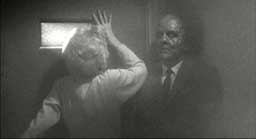
A surprisingly languid, dreamy murder mystery masquerading as a horror flick, THE NIGHT WALKER works overall despite a central problem at its core: we never quite believe that Stanwyck wouldn't know she wasn't dreaming during the villain's "Gaslight" sequences (due to no fault of Stanwyck's, though, who's perfectly cast and who gives 100% here as only one of Hollywood's golden age pros could). It's not difficult to figure out fairly early who that villain is, or what all that "gaslighting" is in service of, but that's never mattered in a solid, atmospheric mystery – style and ambience and suspense will always trump logic when we're watching such a movie. Despite many critics frequently citing William Castle's penchant for gimmickry rather than touting his directorial skills, Castle shows once again here his uncanny, unerring ability to craft an unsettling, nightmarish shock sequence. When he shows Stanwyck having her first extended dream sequence, the soundtrack suddenly drops out and it gets very quiet as Stanwyck fumbles through the smoky laboratory, perfectly replicating a nightmare sensibility as the on-screen timeline seems to stretch out and then stop, before a half-melted Hayden Rorke is revealed, and Stanwyck, the great star that she was, unleashes these absolutely unhinged screams that jar the viewer in a most unnerving way (when Castle re-starts the dream again, and has Stanwyck flip out, screaming, "I can't wake up!" over and over, the effect is electric). Castle tops himself with the surreal "dream" sequence wedding, shot with his assured, even peculiar precision, as off-kilter shots of a waxwork minister and witnesses speak without moving their mouths, slightly bobbing back and forth to weird effect. Scripter Robert Bloch, borrowing moments from Hitch's PSYCHO (the mansion's staircase) and reportedly his favorite movie, LES DIABOLIQUES (the literal "unmasking" of the villain), crafts a story right in line with Castle's usual preference for an earthly venality-over-supernatural twist, as Castle maintains a slow, steady, measured pace that's rather brilliantly complemented by composer Vic Mizzy's (THE GHOST AND MR. CHICKEN, TV's THE ADDAMS FAMILY) feline, playful harpsichord-laden themes. It may not be the kind of "horror" many new audiences prefer today, but THE NIGHT WALKER is an unusually well-crafted bit of gauzy, ethereal suspense.
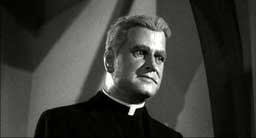 Far
more shocking, unfortunately, is this DVD transfer. Anamorphically enhanced,
this 1.85:1 widescreen standard DVD transfer suffers from some of the worst
authoring issues this reviewer has seen in some time. Severe motion judder whenever
the camera pans (I'm certainly no technical expert, but I'm guessing my equipment's
progressive scan can't properly interpret this old interlaced image and low,
low bit rate), and jaggies on anything white or gray, along with alias
artifacting, make this milky, filmy, super-soft, heavily-grained image a nightmare
to watch on a large monitor (my old VHS copy of THE NIGHT WALKER, even though
it's full-frame, looks miles better). Also of note: every source this
reviewer accessed listed THE NIGHT WALKER's run time at 86 minutes (which is
also listed on the back of this disc holder). However, the actual run time here
comes out to about 82 minutes – could this be an edited source print,
or is the loss from a possible PAL conversion?
Far
more shocking, unfortunately, is this DVD transfer. Anamorphically enhanced,
this 1.85:1 widescreen standard DVD transfer suffers from some of the worst
authoring issues this reviewer has seen in some time. Severe motion judder whenever
the camera pans (I'm certainly no technical expert, but I'm guessing my equipment's
progressive scan can't properly interpret this old interlaced image and low,
low bit rate), and jaggies on anything white or gray, along with alias
artifacting, make this milky, filmy, super-soft, heavily-grained image a nightmare
to watch on a large monitor (my old VHS copy of THE NIGHT WALKER, even though
it's full-frame, looks miles better). Also of note: every source this
reviewer accessed listed THE NIGHT WALKER's run time at 86 minutes (which is
also listed on the back of this disc holder). However, the actual run time here
comes out to about 82 minutes – could this be an edited source print,
or is the loss from a possible PAL conversion?

San Francisco, 1890. In the foggy back alleyways of the Paris of the West, young women are getting ripped apart by a large, growling man-like creature, and Police Commissioner Harvey Misbach (Gilbert Green, HOMICIDAL, EXPERIMENT IN TERROR) needs help with the investigation. Enter Brett Kingsford (Leslie Nielsen, FORBIDDEN PLANET, THE POSEIDON ADVENTURE), rich bon vivant, arrogant rake, and dabbler in occult studies. Called secretly to Misbach's office, Kingsford identifies as Sumerian the tiny statues that have been left with the murder victims, each portraying the image of a demon emerging from a man. Calling on Chinese merchant Chi Zang (Peter Brocco, OUR MAN FLINT, JEKYLL AND HYDE...TOGETHER AGAIN), Kingsford learns that the statues are connected to a mummified Sumerian token that predicts a series of seven killings... with the victims somehow connected in the past. Meanwhile, Kingsford's friend, antique dealer Robert Vandenburg (Peter Mark Richman, TV's CAIN'S HUNDRED, FRIDAY THE 13TH PART VIII: JASON TAKES MANHATTAN), appears to be quite troubled — and not because he's marrying the beautiful, vivacious smart-ass Evelyn Lang (Judi Meredith, JACK THE GIANT KILLER, QUEEN OF BLOOD) — with a further sense of urgency gripping Vandenburg after meeting hooded medium Professor Malaki (a never-seen Werner Klemperer, TV's HOGAN'S HEROES, THE WICKED DREAMS OF PAULA SCHULTZ, in Bud Westmore's horror makeup,). Can Kingsford quit making cynical wisecracks with his manservant Nikola (Charles Bolender, TV'S JACKIE GLEASON: AMERICAN SCENE MAGAZINE) long enough to stop the murders?
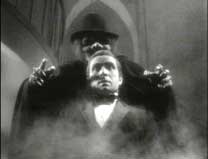 A
remarkable find for lovers of "lost" vintage TV and 1960s occult offerings,
DARK INTRUDER finally makes its debut on DVD. Guided by pro producer Jack Laird
(TV's BEN CASEY, NIGHT GALLERY, KOJAK) and written by Britisher "Barre
Lyndon" (Alfred Edgar, THE LODGER, HANGOVER SQUARE, THE WAR OF THE WORLDS),
DARK INTRUDER was shot as a TV pilot for Laird's proposed series, "The
Black Cloak," where rich dilettante/dabbler Leslie Nielsen would investigate
supernatural occurrences in Gay 90s San Francisco. Produced through Alfred Hitchcock's
Shamley Productions (which by 1964 had been sold back to Universal in exchange
for Hitch taking a large stake in the movie studio), the pilot was screened
by first-look network NBC, where execs deemed it too violent for 1965 TV standards.
Instead of taking a total loss on it, Universal decided to release it to theaters
(just as they had done the year before with director Don Siegel's ultra-violent
TV movie adaptation of Hemingway's THE KILLERS with Lee Marvin and Ronald Reagan).
Buried on the bottom of a exploitation double bill with director William Castle's
Joan Crawford shocker, I SAW WHAT YOU DID, DARK INTRUDER was quickly forgotten
in the summer of 1965 (I SAW WHAT YOU DID was a money loser), with occasional
appearances on 1970s late, late TV keeping its cult reputation alive by fans
of literate TV ephemera (no doubt due to Castle's high profile at the time,
no less than prickly Howard Thompson of The New York Times reviewed
the double bill back in '65... and promptly championed the anonymous DARK INTRUDER
over Crawford's big-name vehicle. To no avail).
A
remarkable find for lovers of "lost" vintage TV and 1960s occult offerings,
DARK INTRUDER finally makes its debut on DVD. Guided by pro producer Jack Laird
(TV's BEN CASEY, NIGHT GALLERY, KOJAK) and written by Britisher "Barre
Lyndon" (Alfred Edgar, THE LODGER, HANGOVER SQUARE, THE WAR OF THE WORLDS),
DARK INTRUDER was shot as a TV pilot for Laird's proposed series, "The
Black Cloak," where rich dilettante/dabbler Leslie Nielsen would investigate
supernatural occurrences in Gay 90s San Francisco. Produced through Alfred Hitchcock's
Shamley Productions (which by 1964 had been sold back to Universal in exchange
for Hitch taking a large stake in the movie studio), the pilot was screened
by first-look network NBC, where execs deemed it too violent for 1965 TV standards.
Instead of taking a total loss on it, Universal decided to release it to theaters
(just as they had done the year before with director Don Siegel's ultra-violent
TV movie adaptation of Hemingway's THE KILLERS with Lee Marvin and Ronald Reagan).
Buried on the bottom of a exploitation double bill with director William Castle's
Joan Crawford shocker, I SAW WHAT YOU DID, DARK INTRUDER was quickly forgotten
in the summer of 1965 (I SAW WHAT YOU DID was a money loser), with occasional
appearances on 1970s late, late TV keeping its cult reputation alive by fans
of literate TV ephemera (no doubt due to Castle's high profile at the time,
no less than prickly Howard Thompson of The New York Times reviewed
the double bill back in '65... and promptly championed the anonymous DARK INTRUDER
over Crawford's big-name vehicle. To no avail).
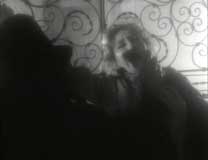
Directed with tight assurance by Harvey Hart (THE SWEET RIDE, THE PYX), DARK INTRUDER runs a lightning fast 59-minutes, distinguishing itself right out of the gate with an opening murder scene that's heavy on carefully-crafted studio atmosphere (cinematographer John F. Warren, TV's THRILLER, ALFRED HITCHCOCK PRESENTS) and some distinctly un-1960s network TV-like POV shots of the killer creature pursuing his victim (complimented greatly by composer Lalo Schifrin's spooky score). Cocky, suave Nielsen, perfectly cast as is Richman, has a fun character to work with: a combination Sherlock Holmes (what, exactly, is that "headache powder" Kingsford is taking?) with well-read deduction skills (and a secret lab), mixed with the Scarlet Pimpernel (Nielsen hits just the right note of a dedicated crime fighter masquerading as a cynical, superficial fop). Lyndon's script is enjoyably dense in occult detail (mixing in a few Lovecraft references, for good measure), while the just-right insouciant tone of the frequent banter is quite amusing; the bright, funny Meredith is a hoot when "invading" a clearly annoyed Nielsen's bachelor flat ("You saucy thing! You'd turn any girl's head with your flattery!"), or commenting on Nielsen's small manservant Nikola ("I declare every time I see him he's shrunk another inch!" to which a sardonic Nielsen throws back, "Yes, dear chap — destined for ultimate evaporation, I'm afraid,"). What a shame this literate, amusing antecedent to TV's THE SIXTH SENSE and KOLCHAK THE NIGHT STALKER never got off the ground.
DARK INTRUDER's full-screen, 1.37:1 black and white transfer has the same authoring and bit rate problems as THE NIGHT WALKER, but detail and sharpness are necessarily better since there's less image detail to convert. Blacks are milky, and the image is a tad contrasty in spots. Print damage like scratches and dirt pop up occasionally. No extras, unfortunately (too bad someone didn't think of interviewing the well-spoken Peter Mark Richman for this one). (Paul Mavis)